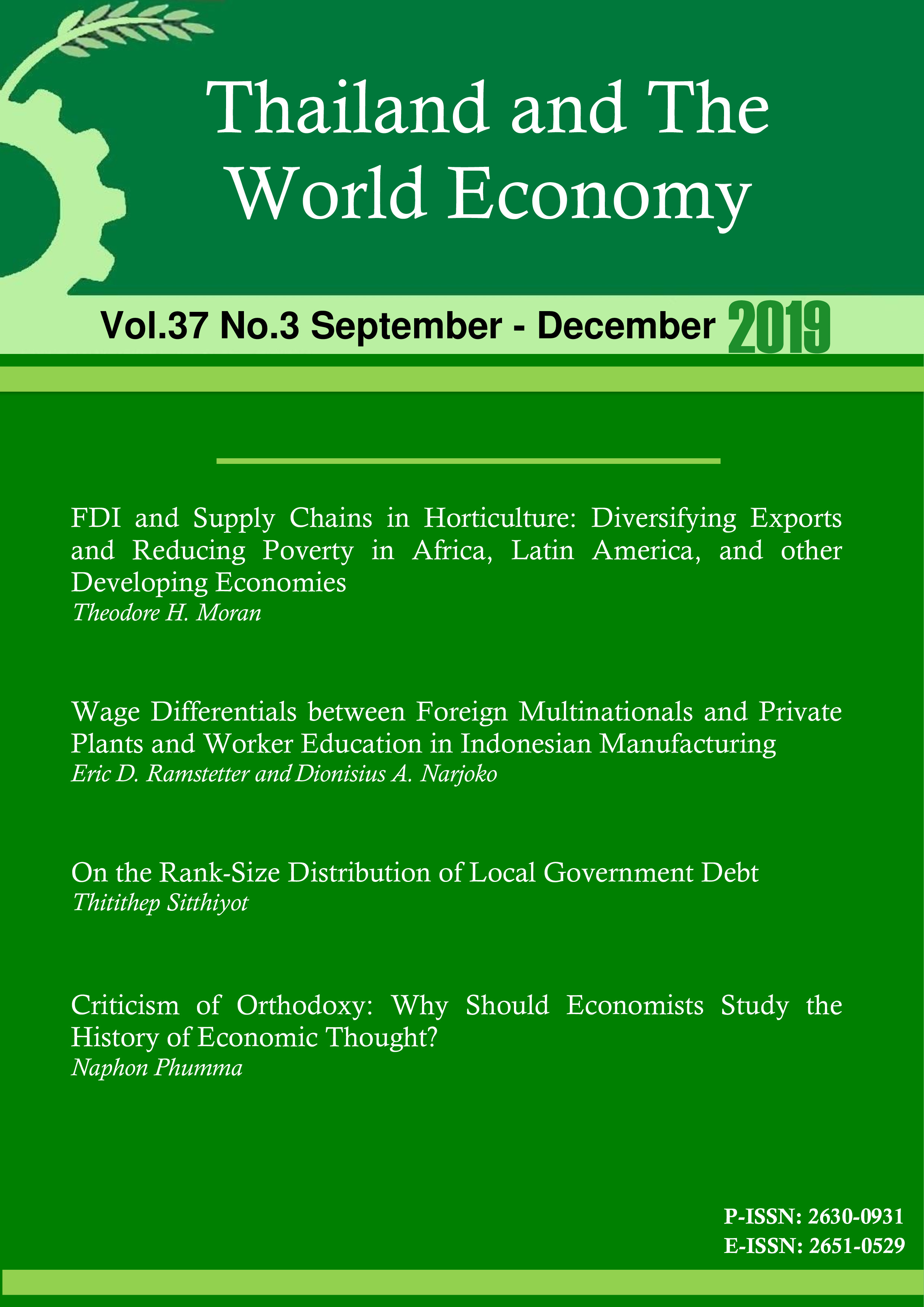On the Rank-Size Distribution of Local Government Debt
Keywords:
Local Government Debt, Power Law, Self-Organized Criticality, Complex Adaptive System, Risk and Uncertainty ManagementAbstract
Rank-size distributions of local government debt, regardless of the way in which data is categorized, whether by region, type, or all local governments, are found not to be normally distributed but rather consistent with a mathematical principle known as power law. This implies that local government borrowing resembles a complex adaptive system in the sense that it is self-organized with positive feedback among concerned parties. In such a system, a critical point could be reached wherein a local government debt crisis eventually disrupts a government’s fiscal and financial status as well as that country’s economic system. This kind of event is extremely difficult to predict in advance because it represents both an emergent phenomenon and scale-invariance. One cannot really tell beforehand what type or size of local government debt will transpire, or which local government would cause such a crisis. Therefore, rules and regulations designed to regulate and monitor local government borrowing, as well as manage the risk of local government debt, should emphasize mitigation measures in addition to disciplinary procedures. This study proposes a rule that requires each local government to maintain enough reserves to service its debts. The rationale is that, in the event of a local government debt crisis, the local government, indirectly affected by such a crisis, may encounter problems from liquidity shortage and therefore not be able to pay principals and/or interest to its creditors. Having such mitigation measures in place should not only lower the probability of local governments defaulting on debts, but also help build trust in the system.
References
Alphametircs. (2011). Risk model development phase 3: final report. Public Debt Management Office.
Bak, P. (1999). How nature works: the science of self-organized criticality. New York: Copernicus.
Ball, P. (2004). The self-made tapestry: pattern formation in nature. New York: Oxford University Press.
Ball, P. (2005). Critical Mass: How one thing leads to another?. London: Arrow Books.
Ball, P. (2012). Why society is a complex matter: Meeting twenty-first century challenges with a new kind of science. Berlin: Springer.
Barabási, A-L. (2016). Network science. Cambridge: Cambridge University Press.
BBC Radio 4. (2018). The next crash. Analysis. Retrieved from https://www.bbc.co.uk/programmes/m00017rd.
Buchanan, M. (2001). Ubiquity: Why catastrophes happen. New York: Three Rivers Press.
Chunhachinda, P. (2010). International financial management, Fifth edition. Bangkok: M.A.H. Printing. (in Thai).
Department of Local Administration. (2018). List of local administrative organizations. Retrieved from http://www.dla.go.th/ work/abt/. (in Thai).
Eiteman, D. K., Stonehill, A. I., & Moffett, M. H. (2010). Multinational business finance. Twelfth edition. Singapore: Pearson.
Fiscal Policy Office. (2016). Fiscal risk statement 2015. Retrieved from http://www2.fpo.go.th/FPO/index2.php?mod=Content&file=contentview&contentID=CNT0017605&categoryID=CAT0001401. (in Thai).
Foxley, J. (2013). Diversifying international reserves: A case for going LatAm. The 6th Annual National Asset-Liability Management Conference, 23-24 July. Singapore.
Gabaix, X. (2016). Power laws in economics: An introduction. Journal of Economic Perspectives, 30(1), 185-206.
Haldane, A. G. & May, R. M. (2011). Systemic risk in banking ecosystems. Nature, 469 (7330), 351-355.
Haldane, A. G. & Nelson, B. (2012). Tails of the unexpected. Bank of England. Retrieved from http://www.bankofengland.co.uk/publications/ Pages/news/2012/058.aspx.
Helbing, D. (2013). How and why our conventional economic thinking causes global crises. Econophysics Forum. Retrieved from http://www.unifr.ch/econophysics/.
Hillis, W. D. (2015). Cause and effect, ed. by J. Brockman in This idea must die: Scientific theories that are blocking progress. New York: Harper Perennial
Holland, J. (1996). Hidden order: How adaptation builds complexity. New York: Basic Books.
Kirman, A. (2010). The economic crisis is a crisis for economic theory. CESifo Economic Studies, 56(4), 498-535.
Mandelbrot, B. & Hudson, R. L. (2008). The (mis)behaviour of markets: A fractal view of risk, ruin and reward. London: Profile Books.
Nagel, K. & Paczuski, M. (1995). Emergent traffic jams. Physical Review E, 51(4), 2909-2918.
Ormerod, P. (1999). Butterfly economics. London: Faber and Faber.
Ormerod, P. (2006). Why most things fail: And how to avoid it. London: Faber and Faber.
Ostrom, E. (1999). Coping with tragedies of the commons. Annual Review of Political Science, 2(1), 493-535.
Ostrom, E. & Janssen, M. A. (2004). Multi-level governance and resilience of social-ecological systems, ed. by M. Spoor in Globalization, Poverty, and Conflict: A Critical ‘Development’ Reader. Ch.13. Dordrecht: Kluwer Academic Publishers.
Pornpipat K. & Tanlamai, U. (2010). Risk management in Thai state-owned enterprises. Chulalongkorn Business Review, 32(125), 74 - 90. (in Thai).
Public Debt Management Office. (2018). Local administrative organization debt outstanding. Data File. Retrieved from http://www.pdmo.go.th/debtoflocal.php. (in Thai).
Sitthiyot, T. (2013). Debt of agencies under state supervision in Thailand: Risk and Uncertainty of Contingent Liabilities. Thailand and the World Economy, 31(1), 23-59.
Sitthiyot, T. (2015). Macroeconomic and financial management in an uncertain world: what can we learn from complexity science?. Thailand and the World Economy, 33(3), 1-34.
Sornette, D. (2009). Dragon-kings, black swans and the prediction of crises. CCSS Working Paper No.CCSS-09-005. EidgenÖssische Technische Hocschule Zürich. Swiss Federal Institute of Technology Zürich.
Taleb, N. N. (2010). The black swan: The impact of the highly improbable. New York: Random House Trade Paperbacks.
The Thai Bond Market Association. (2018). Summary statistics. Retrieved from http://www.thaibma.or.th/EN/Market/ SummaryStatistics.aspx.







